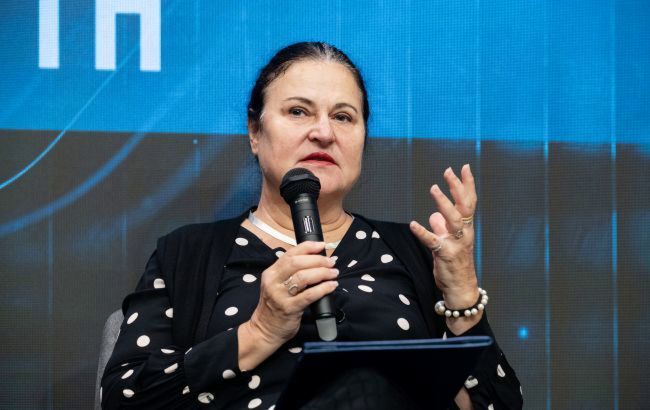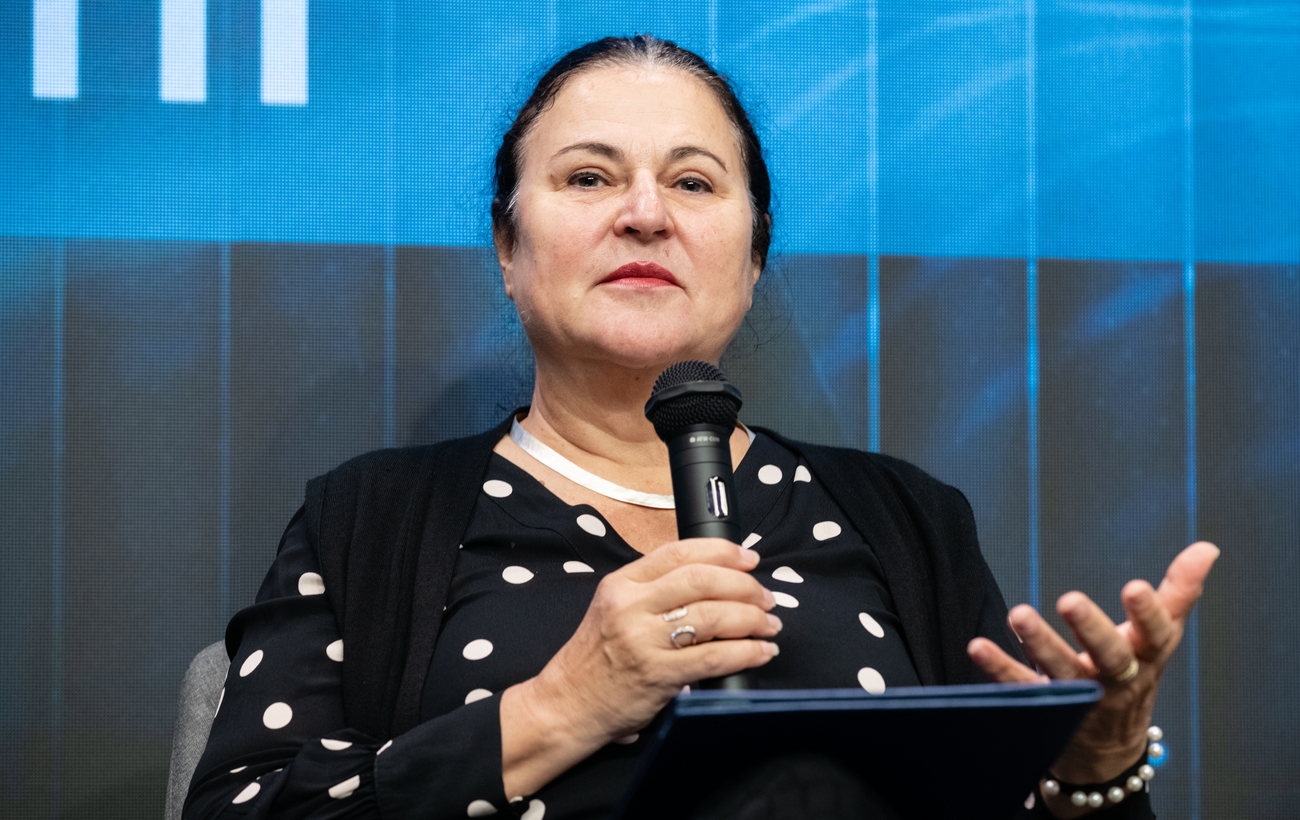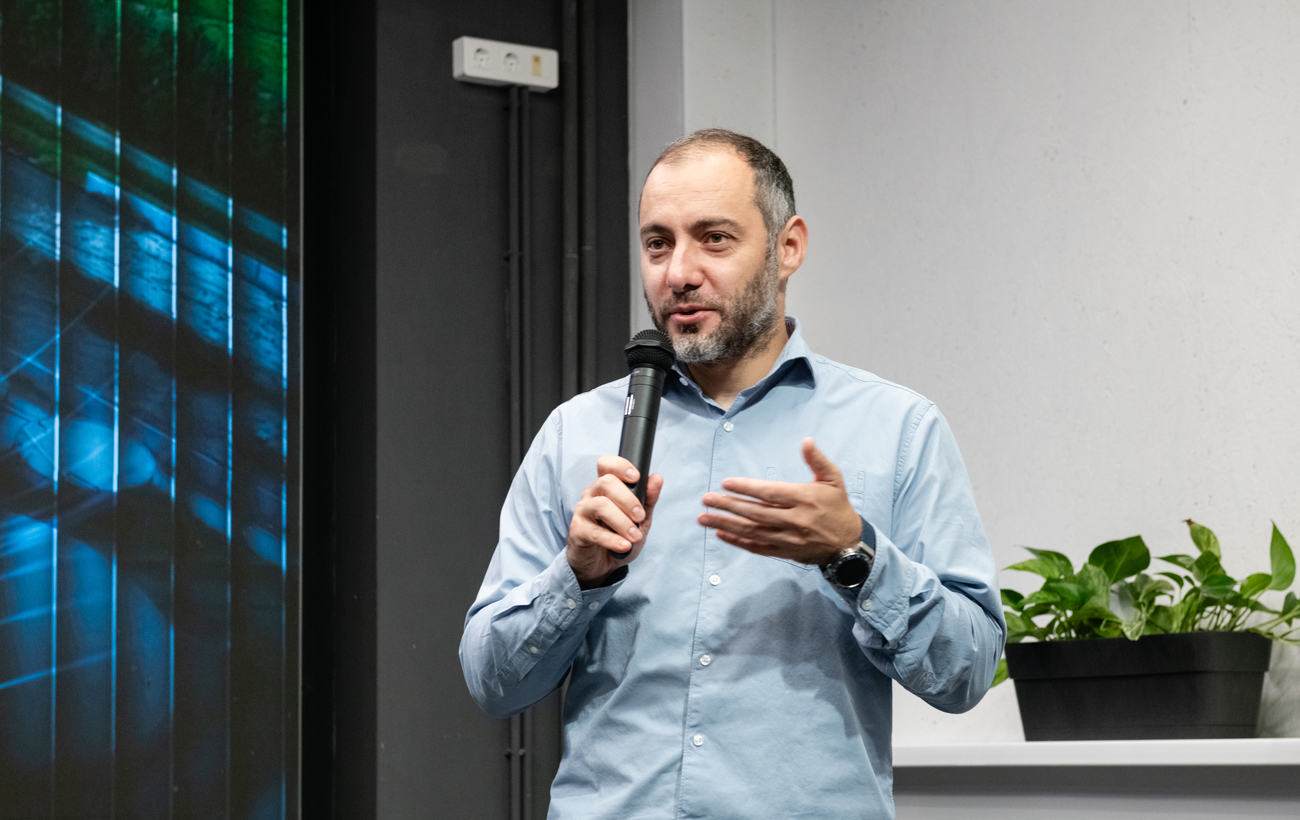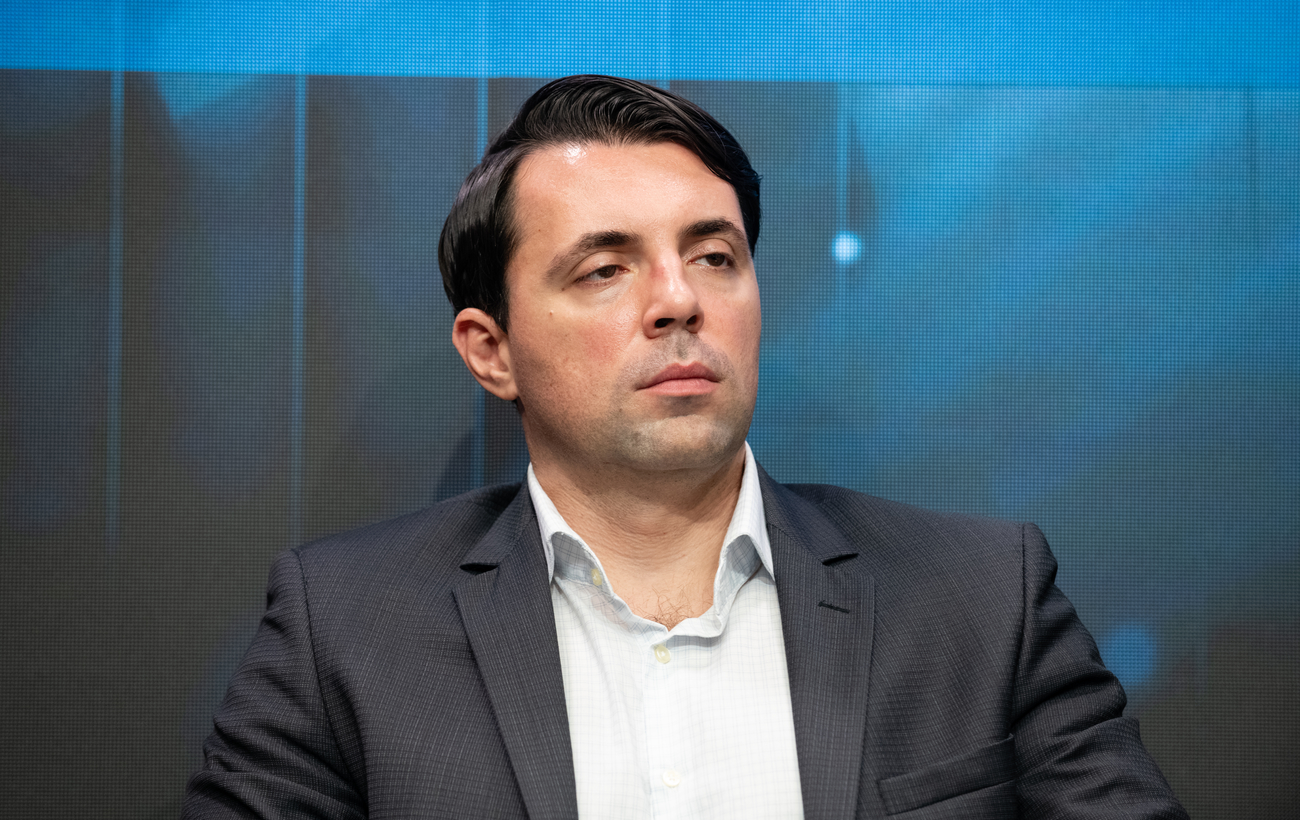Preparing for winter: What reforms and how much money Ukrainian energy sector needs
 EU Ambassador to Ukraine Katarína Mathernová at the We Build Ukraine Center conference (photo: We Build Ukraine)
EU Ambassador to Ukraine Katarína Mathernová at the We Build Ukraine Center conference (photo: We Build Ukraine)
The energy sector has suffered significant damage during the full-scale invasion. Billions of dollars in investments and assistance from international players are needed to restore the large-scale destruction.
Projects that can attract major foreign companies, the necessary reforms to be implemented, the sector’s preparation for the upcoming winter, and new technologies became the focus of discussion at the conference Ukrainian Energy: Strategies for Recovery and Development, held on September 16 by the independent think tank We Build Ukraine.
Read more about the discussion in the RBC-Ukraine article.
Necessary reforms in the energy sector
Ukraine’s energy sector is receiving significant support from European partners, whose role has become especially crucial during the war. The Ambassador of the European Union to Ukraine, Katarína Mathernová, said that the EU has provided Ukrainian energy companies with assistance totaling €3 billion, not including equipment supplies. She gave a striking example: a thermal power plant in Vilnius (Lithuania) was dismantled and transported to Ukraine.
"This equipment is currently stored in Ukraine and, fortunately, it was not destroyed during the latest attacks and can be used further," Mathernová commented, adding that in recent times our country has made great progress in developing distributed generation.
An important role in implementing energy projects is played by credit financing provided by EU financial institutions, in particular the European Bank for Reconstruction and Development. The bank provides guarantees worth hundreds of millions of euros for private businesses in Ukraine and runs a program to reduce risks for renewable energy projects.
Significant financing from European banks is also being received by Naftogaz for the purchase of gas to ensure passage through the 2025–2026 autumn-winter season, as well as by Ukrenergo for procuring equipment to guarantee the stable operation of the power system.
At the same time, Katarína Mathernová emphasized that Ukraine must continue reforming its energy sector. "This includes market liberalization, integration of Ukraine’s electricity market with the EU energy market, continuation of gas sector reforms, and the creation of a truly independent regulator. We are in active discussions on these issues," she said.

Photo: EU Ambassador to Ukraine Katarína Mathernová presented a list of reforms that must be implemented in the Ukrainian energy sector (We Build Ukraine)
The Ambassador added that reforming the energy sector is necessary not only for integrating Ukraine’s market into the European space, but also for obtaining external financing under the European Ukraine Facility program.
The importance of European assistance was confirmed by the head of the We Build Ukraine think tank, Oleksandr Kubrakov, who added that partner support has stimulated the construction of new capacities in wind and solar energy. "There are already nearly 4 GW of wind power in the pipeline alone, and households and small and medium-sized businesses have added about 1.5 GW of distributed solar generation," Kubrakov said.

Head of the We Build Ukraine think tank, Oleksandr Kubrakov, said that despite constant shelling, the energy sector continues to develop and attract investment (We Build Ukraine)
The need for $200 billion in investments
The international consulting company Boston Consulting Group (BCG) presented a forecast for the development of Ukraine's energy sector until 2040. During this period, the level of consumption of all energy resources is expected to return to 2022 levels, while the share of renewables will grow significantly.
"By 2040, energy consumption will increase, and the share of electricity in the overall structure will rise to 30%. This will lead to a decrease in gas consumption," said Bálint Szilhávy, Senior Expert at BCG in Central and Eastern Europe.
Nuclear energy will remain a key source in Ukraine’s energy balance, but a significant increase in the share of renewables is expected. The levelized cost of electricity (LCOE) in 2035 is projected to be lowest for existing nuclear plants ($50 per megawatt-hour), wind ($54 per MWh), and solar generation ($59 per MWh), according to BCG analysts.
Ukraine will remain an electricity importer until 2040, but from 2045 it could become a net exporter. Further development of the energy sector requires significant investment — about $200 billion over the next 25 years. Szilhávy added that most of these funds will be invested in electricity generation, with oil and gas ranking second and third, respectively.
"We expect Ukraine to develop an even more decentralized energy system, which will provide an additional competitive advantage. This could attract $200 billion in investments, combining public and private financing sources," the analyst commented.
American technologies for gas production
Despite the war, gas production projects continue to develop in Ukraine. Present at the conference, the Executive Director of DTEK Naftogaz, Yevhen Bondarenko, said that Ukraine has the largest gas reserves in Europe after Norway. DTEK Group continues to actively invest in gas exploration and production.
"We are trying to maintain production. Since the beginning of the war, we have invested more than 12 billion UAH in drilling new wells, more than 60% of which are exploratory," Bondarenko said.
Efforts by extraction companies were also highlighted by the CEO of Smart Energy Group, Oleksiy Zayets. "Extraction companies are doing everything possible and impossible to restore production," he noted, acknowledging that for this winter, Ukraine will still need significant volumes of imported gas.
One promising direction for increasing gas production is the exploration and extraction of so-called tight gas — gas from unconventional reservoirs — since finding large deposits of traditional gas, which has been extracted for decades, is becoming increasingly difficult.
"You are gradually moving away from traditional and shifting to unconventional [reserves]. I am not talking about shale, but rather about tight gas," said Andriy Kobolyev, co-founder of the investment company Eney. He added that extracting complex reserves requires new technologies and capital.
Ukraine's agreement with the United States on creating an American-Ukrainian Investment Fund opens the way to Western financing and expertise. Kobolyev noted that even China has worked for decades with the American engineering company Halliburton in the field of tight gas and shale gas extraction.

Andriy Kobolyev, co-founder of the investment company Eney, noted that a partnership with the US opens access to new gas production technologies (We Build Ukraine)
"China, with all its technical capabilities, still relies on American expertise," Kobolyev said, adding that tight gas extraction requires extensive infrastructure with many wells operating as one large system. Only then will the cost of such gas be competitive with traditional gas. Ukrainian oil and gas projects already have a high degree of readiness, which increases their attractiveness in the eyes of Western partners, he commented.
Gas is also an important energy resource for the agro-industrial sector. For example, drying one ton of grain requires 10 cubic meters of gas, and gas accounts for 50% of sugar production costs. Such figures were cited at the We Build Ukraine conference by Oleh Khomenko, CEO of the Ukrainian Agri-Food Council (UCAB). He added that the Ukrainian agricultural sector consumes about 1 billion cubic meters of gas per year.
Decision that could undermine winter readiness
The largest consumer of gas remains the municipal sector, which is actively preparing for the heating season. The technical readiness of equipment across various regions exceeds 80%, said Oleksandr Slobozhan, Executive Director of the Association of Ukrainian Cities. Water utilities are also preparing their equipment, inspecting the water supply, and sewage systems.
The main risks for the heating season lie in the financial and administrative spheres, Slobozhan noted. Due to the gap between gas and heat tariffs and a number of long-standing issues, the heating utilities sector chronically lacks funds and cannot fully settle payments with Naftogaz. Water utilities have accumulated large debts for electricity. As of now, municipal utility companies owe 67 billion hryvnias for gas, and water utilities owe several more billion for electricity.
This financial shortfall undermines the stability of municipal enterprises and creates risks for their proper operation during the heating season. The situation is further complicated by a proposal from the National Energy and Utilities Regulatory Commission to disconnect municipal enterprises with outstanding debts.
"They're proposing that starting in October, debtors — including heating utilities and water utilities — can be disconnected without a court decision. If these enterprises are shut off, no mobile boiler houses will save us. This NEURC decision could jeopardize the entire heating season," said the Executive Director of the Association of Ukrainian Cities. He suggested exempting the municipal sector from this rule for the duration of martial law.

Oleksandr Slobozhan, Executive Director of the Association of Ukrainian Cities, spoke about the financial and administrative challenges of getting through the heating season (We Build Ukraine)
Slobozhan also emphasized the need to replenish the state budget’s reserve fund, which could finance urgent repairs and restoration of major heat generation facilities in regional centers. At the same time, he argued that local communities should not lose part of their tax revenues, as those funds will be essential for supporting the municipal sector throughout the winter.
Ways to reduce electricity costs for industry
One of the key topics discussed at the conference was the cost of electricity for industrial enterprises. In August, electricity prices in Ukraine were higher than in neighboring European countries such as Poland and Slovakia, said Oleksandr Kalenkov, President of the Ukrmetalurgprom.
As a result, Ukrainian metallurgical companies struggle to compete with European plants. The share of electricity in the production cost of metal products is significant: for ferroalloy enterprises, it can reach 40–60%, and for full-cycle plants producing metal from iron ore, such as Kryvorizhstal, it has increased from 7% to 20% since the start of the full-scale invasion.
To lower electricity costs, Kalenkov proposed allowing large consumers to purchase long-term access to international transmission lines.
"Currently, these contracts can be for a day, two days, or a few days in advance. By the end of the year, monthly contracts are promised (Ukrenergo announced the launch of monthly auctions for transmission access), but what will really improve the situation is the ability to sign contracts for six months or a year ahead," explained Kalenkov.
Typically, long-term access to international electricity networks is cheaper than short-term (spot market) access. By securing transmission capacity for electricity imports on a long-term basis, consumers can expect lower final electricity costs.
"If it’s the spot market, prices are much higher. Long-term contracts, however, would allow our companies to buy imported electricity at lower costs," Kalenkov added.

Oleksandr Kalenkov, President of Ukrmetalurgprom, spoke about the importance of implementing long-term contracts in the electricity market (We Build Ukraine)
Another option for large industrial companies is gaining access to long-term contracts to purchase electricity directly from generators. For example, industrial enterprises could buy electricity from Energoatom for extended periods.
"Currently, our consumers have contracts with Energoatom for decades or a week at a time. That's not normal. In European countries, our competitors are used to working with generation contracts for one, two, or three years ahead. They shouldn't depend on short-term market fluctuations," Kalenkov said.
Electricity costs in Ukraine are largely driven by attacks on generating capacities and networks. Constant strikes on energy infrastructure pose a significant challenge for energy companies and require increased spending on restoration.
Dmytro Yehudin, COO of DTEK Energy, noted that a large share of thermal generation has been attacked over 200 times since the full-scale war began, but it has been restored and is being prepared for the upcoming heating season. Since February 2022, the company has invested 18 billion UAH in coal extraction and 9.6 billion UAH in repairing thermal power plants.
Since the start of the war, DTEK Energy specialists have brought thermal power units back from scratch to a certain capacity around 50 times, whereas before the war, this was a rare and difficult task.

Dmytro Yehudin, COO of DTEK Energy, said that since February 2022, the company has invested nearly 28 billion UAH in coal extraction and thermal power plant repairs (We Build Ukraine)
Yehudin added that continued cooperation with international partners is needed to supply critical equipment, and the National Emissions Plan must be updated, considering the generation deficit, including fossil fuel generation. "Rapid shutdowns of units will increase electricity costs and shortages," he said, emphasizing the need to develop mechanisms to resolve the debt situation in the electricity market.
Potential of batteries over the next 4–5 years
Recently, a new player has entered the market — energy storage systems, whose total capacity already exceeds 220 MW. Former Head of the Board of Ukrenergo (2020–2024) and co-founder of the private company Negen, Volodymyr Kudrytskyi, said that the cost of batteries has fallen tenfold over the past seven years. Together with solar, wind, and gas-piston generation, they will form the backbone of Ukraine’s future energy system.
The Ukrainian market still has significant potential for increasing the number of energy storage systems. There remains a major opportunity for investments in batteries for energy arbitrage — buying energy during low-price hours and selling during high-price hours, Kudrytskyi noted.

Former Ukrenergo head Volodymyr Kudrytskyi said the market has significant potential for battery development over the next 4–5 years (We Build Ukraine)
During the April–October period, the energy system needs to shift energy from daytime hours, when there is abundant sunlight, to evening hours, when there is a deficit, amounting to about 8,000–12,000 (up to 15,000) MWh per day, Kudrytskyi calculated. Today’s battery capacity stands at about 450 MWh, which means there is still considerable room for growth.
"The market is not saturated at all… There is a huge amount of untapped opportunity for arbitrage. For the next 4–5 years, it will be safe to invest in this business," the former Ukrenergo chief commented.
Necessary draft laws for EU integration
Oleksiy Orzhel, Head of the Kyiv Office of the Energy Community Secretariat, supported the idea of expanding cross-border electricity transmission capacity. To this end, Ukraine must continue implementing its roadmap for integrating the national electricity market into the European one. Market coupling represents revolutionary change for Ukraine that could happen in the near future, Orzhel emphasized.
To achieve this, Ukraine needs to adopt a number of important draft laws, including the law on market coupling, which has passed its first reading and envisions the synchronization of market operating modes. The next draft law concerns ensuring the independence of the regulator — NEURC. European partners have proposed increasing their involvement in the selection of commission members. “The bill is aimed at improving the situation and boosting trust in the regulator in the future,” Orzhel said.
The third draft law in this package should simplify conditions for connecting new facilities to the power grid. "Ukraine must become part of European energy markets. This is a huge opportunity for Ukraine — greater market liquidity, new investments, new consumers, new generation, and long-term contracts for cross-border capacity," Orzhel commented.
The Ukrainian energy sector remains one of the eight most promising growth points of the national economy. It continues to recover and expand despite the war.

Oleksandr Kubrakov, head of the We Build Ukraine analytical center, said that integrating Ukraine’s energy market into the European space opens access to investments and technologies (We Build Ukraine)
As already noted, the sector requires significant investment — about $200 billion by 2040. In addition to capital for modernizing production facilities, networks, and gas extraction, it is important to eliminate institutional imbalances, develop mechanisms to overcome the debt crisis, and ensure access to long-term contracts. "Predictability and stable rules are fundamentally necessary for both the gas and electricity markets," said Oleksandr Kubrakov.
It is critically important to continue reforms in line with the course of European integration, since only by merging the national energy market with the European one will it be possible to expand network access and attract powerful international players with their expertise and financial resources for Ukraine’s recovery.

